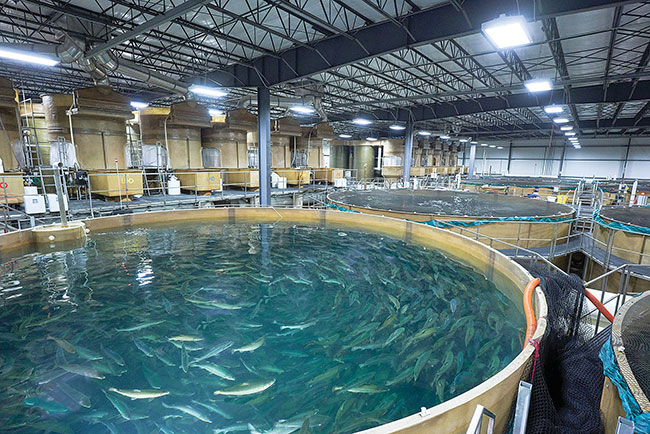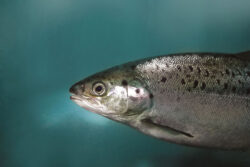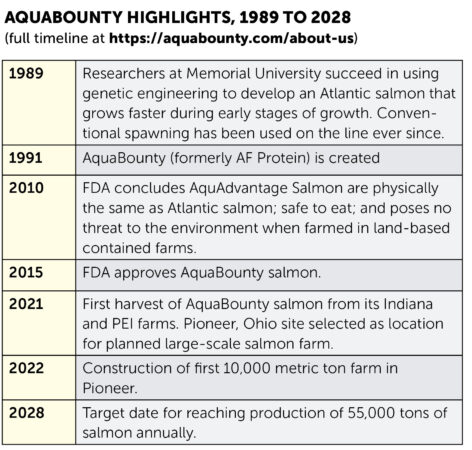
AquaBounty GE Atlantic salmon: the update
July 5, 2023
By Treena Hein
Markets, sales, farm construction and more
 (Photo: AquaBounty Technologies Inc.)
(Photo: AquaBounty Technologies Inc.) It’s been a long road from creation of the AquaBounty genetically engineered (GE) salmon in 1989 to today, with current production sitting at about 1,200 tons a year and sales “at competitive prices” across Canada and the U.S. It’s also approved for sale in Brazil.
“Thanks to this one-time trait modification, AquaBounty’s GE Atlantic salmon reach prime harvest weight faster and more efficiently than conventional Atlantic salmon grown in sea cages,” says AquaBounty president and CEO, Sylvia Wulf. “Typically, in the 18- to 20-month range versus 32-36 months.”
She adds that “demand for our fish continues to exceed our supply, and during March 2023, the Indiana farm had its highest monthly harvest output to date.”
The Albany, Ind. farm is currently the only AquaBounty site where harvest is occurring. The first harvest started over two years ago, during second quarter 2021. Operations there have been impacted by planned maintenance and repair activities, including extensive repairs to the roof of the processing building. Wulf describes the facility as continuing to be “a valuable learning environment for our operations team, helping us refine the efficiency of our production processes, while aiding in design improvements for our farm in Pioneer, Ohio.”
Construction at that site, the company’s first planned large-scale commercial salmon farm, began in April 2022 but was paused on June 2 due to a substantial increase in its estimated cost of completion. Wulf points out that the entire construction industry has been affected by inflation and supply chain challenges, resulting particularly in higher labor costs. (Another factor is continued negotiations with Williams County, of which Wulf didn’t elaborate.)
She says, however, that AquaBounty is committed to the Ohio farm’s construction “with a dedicated effort to be operational in the next several years.”
She also stated that they will undertake a detailed review to evaluate financing options, a potential smaller scope or size for the farm, and a possible phased construction effort for the full 10,000 metric ton design.
She adds, “our growth plans haven’t changed. We will adjust the plan and approach for Ohio and continue to pursue the other growth opportunities we’ve previously communicated.”
Growing demand
Speaking of growth, AquaBounty’s small grow-out facility on Prince Edward Island has been converted to exclusively focus on egg production. This ensures AquaBounty not only has a sufficient supply of GE eggs for its own needs, but is able to have non-GE eggs available to meet the growing demand for this product in the North American market.
 That market looks good at present, says Wulf, with “very positive interest” from a variety of customers in distribution, food service and retailers, particularly in the mid-west and the eastern Atlantic regions. “It is gratifying to see that our customer partners understand the many benefits AquaBounty’s Atlantic salmon provide,” she says, “and that they embrace technology that will bring more food to more people in a cost effective and sustainable manner.”
That market looks good at present, says Wulf, with “very positive interest” from a variety of customers in distribution, food service and retailers, particularly in the mid-west and the eastern Atlantic regions. “It is gratifying to see that our customer partners understand the many benefits AquaBounty’s Atlantic salmon provide,” she says, “and that they embrace technology that will bring more food to more people in a cost effective and sustainable manner.”
The company is also pursuing potential partnerships in land-based RAS salmon farming outside of North America, “We are targeting countries that are large consumers and importers of salmon such as Israel, Brazil and China,” says Wulf. “Israel is a priority for a couple of reasons. They’re very forward thinking in terms of technology, particularly genetic engineering, as well as digital technology. They’re also very progressive in terms of the way they think about renewable energy and water usage, so we think that there’s much to be learned from a market like Israel.”
Looking at the big picture, Wulf sees the landscape of the salmon industry as highly favorable, which supports moving forward with more RAS farms.
“The net pen farmers are seeing their own challenges, which constrains supply,” she explains. “RAS will play a critical role in the supply side in the future since demand remains strong. AquaBounty’s operational expertise, R&D competence and vertical integration create competitive advantages when compared with other RAS farmers.”
AquaBounty will also be investigating the farming of potential new species like shrimp.

Consumer acceptance
There has been much criticism of genetically-engineered livestock from many angles over the last several decades, ranging from food safety to environmental concerns to labelling.
Some countries and regions allow GE livestock production (conventional livestock types and aquaculture species) and others don’t, with the European Union being among those jurisdictions that do not allow it. There are also distinctions in some jurisdictions between genetically-engineered and gene-edited livestock and crops.
Where production of these foods is allowed, labelling has been a concern. As with regulations for livestock and crop production, the rules about labelling genetically-modified (GM, which could be either or both GE and gene-edited) foods around the world are not consistent, as recently noted by Dr. Karen Massel, a research fellow with the Centre for Crop Science at the University of Queensland, Australia. This mean that many consumers may not realize they’re already eating them.
For example, “the most widely-used enzyme in cheese making, rennet, is produced from a GM bacterium,” she recently stated in an article that’s appeared recently in many media outlets. She added that “GMs and gene-edited cereal and oilseed products are also widely used in livestock feeds.”
Regarding food safety of AquaBounty’s GE Atlantic salmon, the U.S. Food and Drug Administration (FDA) long ago held an open public meeting, took public comments and released draft environmental documents for public review. The agency determined that food from the AquaBounty salmon is as safe to eat as food from non-GE Atlantic salmon, with a comparable nutritional profile to conventional farm-raised Atlantic salmon.
However, according to a Pew Research Center survey of people in 20 countries conducted between October 2019 and March 2020, concern about GM foods is widespread globally.
In the survey, the majority of respondents in places such as Russia, Italy, India and South Korea view GM foods as generally unsafe to eat. “The balance of opinion tilts negative even in places where sizable shares say they don’t know enough about GM foods to offer a view,” stated PEW researchers at the time. “In most places, both those with higher and lower levels of education tend to see GM foods as unsafe to eat. However, people with more education, and specifically those who have completed at least three science courses during their secondary or tertiary schooling, are more inclined to see GM foods as safe.”
For her part, Wulf explains that general awareness of GM organisms, as it pertains to all food, has increased since 2019.
She notes that according to qualitative/quantitative research conducted by AquaBounty, “respondents with the highest household income and education levels are the most frequent consumers of seafood and salmon, show highest approval and positive perception of GMOs, and have the highest AquaBounty salmon purchase intent.”
From an environmental perspective, regarding the potential of the AquaBounty GE Atlantic salmon coming into contact with wild populations, the FDA approval process examined biological, geographical, and geophysical constraints that, in combination, “results in an extremely low likelihood” of contact. Many types of physical containment are required, as well as “strict security measures and equipment.” On the sustainability front, Wulf notes that 90 percent of the world’s fisheries are fully fished or overfished.
“We are shifting salmon production out of the ocean to land-based RAS farms,” she says. “We use the latest RAS technology and freshwater tanks to nurture the fish in a safe, sustainable way, leveraging our decades of RAS operational experience. Then, we raise our GE salmon on these farms for even greater efficiency and sustainability.”
Advertisement
- Seattle Fish Co. shares sustainability wins in 2022 Impact Report
- Innovative Microfluidics Tech Revolutionizes Pathogen Detection, Genetic Research





